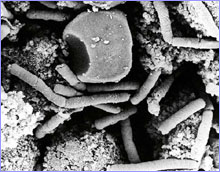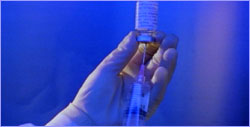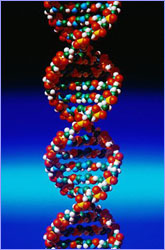|

|

|
|
|
 Antibiotic-resistant anthrax. Plague-Ebola hybrids.
Soviet researchers used genetic engineering to try
to create such "superbugs" in the 1980s. What could
defend against them?
Antibiotic-resistant anthrax. Plague-Ebola hybrids.
Soviet researchers used genetic engineering to try
to create such "superbugs" in the 1980s. What could
defend against them?
|
Future Germ Defenses
by Judith Miller, Stephen Engelberg, and William Broad
The futuristic military research by Soviet scientists
presented America's biodefenders with a grim challenge. The
vulnerability of soldiers and civilians to attack was
growing. In what appeared to be a quiet biological arms
race, much of which took place behind closed lab doors,
offense was outpacing defense.
Even before gene splicing became routine, a germ agent could
be perfected in a few years, while a vaccine often took a
decade to make and win approval. More than a decade after
the Gulf War, America's vaccine against botulinum remained
experimental. Antibiotics were losing the war against
pathogens, which were performing their own, natural genetic
engineering, mutating beyond the reach of the most powerful
drugs.
In the late 1990s, the Pentagon dramatically increased
funding to find new ways of fighting infectious disease,
pouring hundreds of millions of dollars for biodefense into
the Defense Advanced Research Projects Agency, or DARPA, the
little-known agency that had invented the Internet and
stealth technology. DARPA, an arm of the Pentagon, had no
laboratories or scientists of its own. Its managers wanted
to underwrite the most audacious research they could find.
The hope was to spur avenues of inquiry that industry had
ignored or abandoned. It was understood from the beginning
that the research was high risk, that many of the projects
would fail.
 Could a single vaccine guard against an onslaught
of various different germs?
Could a single vaccine guard against an onslaught
of various different germs?
|
|
A vision of the future
The first director of DARPA's Unconventional Countermeasures
Program, Shaun Jones, had his own clear vision of the
future. A doctor and Navy commander who had been a member of
the Navy's elite commando unit, the SEALs, Jones had
traveled the world on secret missions. He believed that
defense against germ weapons required radical new
approaches.
The medical breakthroughs of the late 20th century had often
been driven by profit. Pharmaceutical companies had made
billions targeting individual diseases or maladies. There
were blockbuster drugs to fight allergies, to slow baldness,
to restore sexual prowess. Jones wanted to go in the
opposite direction, to search for breakthroughs that would
provide widespread protection.
One focus was multivalent vaccines that could prime the
body's immune system to ward off a range of microbial
threats. Someday, perhaps, researchers could come up with a
single shot that conferred immunity against, say, plague,
anthrax, and botulinum. Jones was also fascinated by the
potential of antiviral drugs. The viruses, which infiltrate
and hide in human cells, had largely escaped medicine's
weapons. But Jones believed new research might yield new
ways to attack viral enemies like smallpox.
|
 Fragments of "naked DNA" from pathogens are today
being tested as a new form of vaccine.
Fragments of "naked DNA" from pathogens are today
being tested as a new form of vaccine.
|
Pioneers of genetic science
A young colleague of Nobel laureate Joshua Lederberg's,
Jones used the clout of the eminent scientist to recruit
talent for his projects. Among the first researchers he
signed up was Stan Cohen, the Stanford pioneer who, with
Herb Boyer, had made the first recombinant DNA breakthrough
in 1973. By 1998, the program had scientists working on 43
different projects.
Stephen A. Johnston of the University of Texas's
Southwestern Medical Center in Dallas was typical. He had
long nurtured blue-sky ideas. And the National Institutes of
Health, the main source of federal funding for biomedical
researchers, had consistently rejected his proposals as
unlikely to work and unsuitable for financial support.
Backed by a DARPA grant, Johnston used the new biology to
break a pathogen's genes into hundreds of different bits
that he then injected into hundreds of mice. His next step
was to infect the mice with the original pathogen.
Typically, most fell to the onslaught, but a few exhibited
resistance. In that way, Johnston discovered which DNA parts
could be used to bolster the immune response and fight
disease. He called the innovative method Expression Library
Immunization, or ELI. "The basic idea is to let the immune
system tell you what works," he said. Peers hailed his
research as surprising and elegant.
The promise of DNA vaccines
Johnston's research represented a major advance for gene
vaccination, a young field that promised to revolutionize
the science of immunization. Traditional vaccines use
weakened or killed versions of disease organisms, or
inactivated toxins or proteins from pathogens, to give the
body's immune system advance warning of infection and time
to build up defenses. Gene vaccines were just bare
DNA—often plasmids. When injected into the body and
incorporated into cells, the genes expressed a limited set
of the pathogen parts that were nonetheless sufficient to
trigger the immune response. [Learn more about
making vaccines.]
The gene vaccine approach was like a scalpel. Patients would
be injected with precisely what was needed to inoculate them
against a disease. Though experimental, the method showed
promise. It could eliminate the risk of infection associated
with some live and weakened vaccines. It could also ease
production and compliance with federal regulations, the
complexities of which had stymied anthrax vaccines for so
long. Gene vaccines were chemical, not biological. That cut
the chance of contamination and spoilage. Finally, they were
also highly stable. Unlike conventional vaccines that needed
refrigeration, gene vaccines could be stored dry or in
solution under many conditions and temperatures, making
their distribution easier.
Johnston's research was important because it sped up the
identification of suitable DNA snippets, reducing the search
time from a year or more down to months. And he proceeded to
accelerate the process further, finding ways to mechanize it
with tiny robots. His goal, which he called instant
immunization, was to make a new vaccine in a day. If
successful, this promised to help scientists react very
quickly to attacks with designer bugs that no one had ever
encountered before.
 Recent biotechnology allows the "re-shuffling" of
genes to make proteins unknown in nature—and
of potential use in battling germs.
Recent biotechnology allows the "re-shuffling" of
genes to make proteins unknown in nature—and
of potential use in battling germs.
|
|
Anthrax detergents and aerosol vaccines
Some of DARPA's most futuristic work was done by Maxygen, a
small company in Redwood City, California, that Jones
visited just after its founding. The concept was an elegant
elaboration of Cohen and Boyer's discoveries. Where the
pioneers of gene splicing took a gene from one organism and
moved it to another, Maxygen mixed up hundreds, even
thousands of genes to produce a single, new product. Nature
works by a similar process of trial and error. Over millions
of years, bugs mutate and a tiny number become better
equipped to deal with their environment. Maxygen had found a
way to fast-forward the evolutionary process by recombining
genes into hundreds, even thousands of new ways.
One early project involved an enzyme used in detergents like
Tide to dissolve grass stains, which researchers had been
trying for years to improve. Maxygen's scientists shuffled
thousands of genes in different combinations until they
created a new genetic blueprint, one that had never before
existed in nature which involved 26 genes, each sliced from
a different kind of bacteria. The result was a much more
powerful enzyme that could be used in detergents.
|
 Sprays are now available to decontaminate workers
cleaning up hazardous materials. Someday aerosol
vaccines might protect people before, or immediately
after, a bioweapons attack.
Sprays are now available to decontaminate workers
cleaning up hazardous materials. Someday aerosol
vaccines might protect people before, or immediately
after, a bioweapons attack.
|
Jones immediately saw the applications to biodefense. In
1998, DARPA gave Maxygen a $3.8 million contract to refine
the enzyme further, making it strong enough to dissolve not
only grass stains but anthrax bacteria and other germs that
form hardened spores. Perhaps someday the military would
have a detergent that could be sprayed over people and
neutralize an anthrax attack. Another Maxygen contract, for
$7.7 million in 1999, focused on developing unusually strong
gene vaccines that would stimulate the human body into
superimmunity against viral and bacterial invaders. The
military also asked the company to develop aerosol-based
vaccines that could be inhaled to safeguard people against a
broad range of pathogens. A cloud of vaccine, sprayed over
many square miles, was seen as potentially the simplest way
to protect people and animals from epidemics.
A main goal of the research was to shuffle the genetic
material that made pathogen proteins and antigens, which
spur the body to make protective antibodies. By tweaking the
naturally occurring antigens of, say, anthrax, the company
hoped to produce a more powerful immune response. Russell J.
Howard, the president of Maxygen, said the initial results
were encouraging and that it appeared possible to make
vaccines that were not only more powerful but, perhaps,
effective against several diseases at once.
 Defense researchers in the 1960s struggled to make
devices that could rapidly detect and analyze germ
attacks. Today mobile labs, such as Idaho
Technology's RAPID, pinpoint germs in minutes.
Defense researchers in the 1960s struggled to make
devices that could rapidly detect and analyze germ
attacks. Today mobile labs, such as Idaho
Technology's RAPID, pinpoint germs in minutes.
|
|
Rewards of blue-sky research
At first, many of the DARPA projects were criticized because
they tended to be so radical. Work on modifying red blood
cells to knock out toxins and microbes was ridiculed because
no one had ever tried it before, and it was judged, for the
near future at least, as merely intriguing. But other
projects showed quick promise, often raising commercial
interest. Shapiro at Stanford, who discovered an enzyme
common to many bacteria, was widely praised for advances
that promised antibiotics of broad effectiveness. And
Maxygen, whose claims seemed extravagant at first, was
quickly proven right as rival companies rushed to exploit
the shuffling technique.
A measure of the program's success, and Pentagon approval,
was DARPA's expanding budget for defense against biological
weapons, which included not only work on medical treatments
but research on such devices as advanced germ detectors. The
annual budget went from $59 million in 1998 to $162 million
in 2001 and was projected to hit $205 million by 2005. Over
that time, the agency was to spend $1.2 billion, making it a
new power in the world of biomedical research. However, the
benefits of the DARPA-funded research for biological
defense, if any, would be unclear for years, even decades.
And Jones acknowledged that some projects would surely be
"extraordinary failures" and that the value of others would
not be known until they were rigorously tested on people.
After all, a promising response in a petri-dish or a mouse
was no guarantee of human benefit. That kind of evaluation
required the slow, painstaking, carefully regulated process
of clinical trials in which doctors and volunteers took on
the responsibility of searching for unexpected side effects
as well as proving safety and effectiveness.
But Jones and company saw the initiative as a good insurance
policy, a cheap one given the stakes.

|
|
Judith Miller, a correspondent for the
New York Times since 1977, has reported from
throughout the world and concentrated on the Middle
East and the former Soviet republics. Stephen
Engelberg has reported on national security for over
a decade and is now investigations editor for the
Times. William Broad, a science writer for
the Times since 1983, has twice shared the
Pulitzer Prize.
This article was adapted with permission from the
authors' book
Germs: Biological Weapons and America's Secret
War
(Simon & Schuster, 2001).
|
|

|
Photos: (1) Corbis Images; (2-5) WGBH/NOVA; (6) Courtesy
of Idaho Technology; (7) Naum Kazhdam; (8) Jacket
Design—Eric Fuentecilla for Simon and
Schuster.
History of Biowarfare
|
Future Germ Defenses
Interviews with Biowarriors
|
Global Guide to Bioweapons
|
Making Vaccines
Resources
|
Teacher's Guide
|
Transcript
|
Site Map
|
Bioterror Home
Search |
Site Map
|
Previously Featured
|
Schedule
|
Feedback |
Teachers |
Shop
Join Us/E-Mail
| About NOVA |
Editor's Picks
|
Watch NOVAs online
|
To print
PBS Online |
NOVA Online |
WGBH
©
| Updated November 2001
|
|
|
|